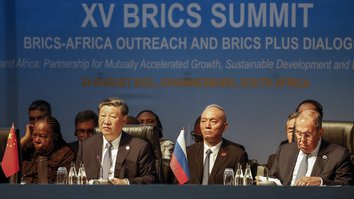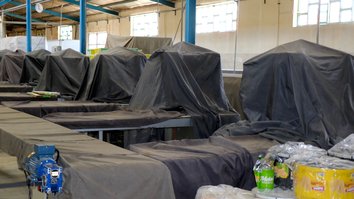Two damaged tankers arrived safely Sunday (June 16) at locations off the coast of the United Arab Emirates after they were attacked near the strategic Strait of Hormuz last Thursday.
The US military on Friday released footage it said showed an Iranian patrol boat removing an "unexploded limpet mine" from one of the vessels.
The Japanese-owned Kokuka Courageous was carrying highly flammable methanol through the Gulf of Oman on June 13 when it came under attack along with the Norwegian-operated Front Altair -- the second assault in a month in the strategic shipping lane.
On May 12, four tankers were sabotaged off the Emirati coast, an attack also largely blamed on Iran.
![Smoke billows from the Norwegian-owned Front Altair tanker after it was attacked in the Gulf of Oman on June 13. [ISNA]](/cnmi_pf/images/2019/06/17/18569-isnapic-585_329.jpg)
Smoke billows from the Norwegian-owned Front Altair tanker after it was attacked in the Gulf of Oman on June 13. [ISNA]
![Iranian troops take part in "National Persian Gulf Day" in the Strait of Hormuz on April 30. [Atta Kenare/AFP]](/cnmi_pf/images/2019/06/17/18570-000_1hi1ez-585_329.jpg)
Iranian troops take part in "National Persian Gulf Day" in the Strait of Hormuz on April 30. [Atta Kenare/AFP]
US Secretary of State Mike Pompeo on Sunday vowed the United States would ensure the strait remains open.
"What you should assume is we are going to guarantee freedom of navigation throughout the strait," he said. "The Iranians should understand very clearly that we will continue to take actions that deter Iran from engaging in this ... kind of behaviour."
"It's unmistakable what happened here," he continued. "These were attacks by the Islamic Republic of Iran on commercial shipping, on the freedom of navigation, with the clear intent to deny transit through the strait."
US President Donald Trump has said the operation had the Iranian regime "written all over it."
British Foreign Secretary Jeremy Hunt concluded that responsibility "almost certainly" lies with Iran.
"These latest attacks build on a pattern of destabilising Iranian behaviour and pose a serious danger to the region," Hunt said in a statement.
The Foreign Office statement pinned the blame for Thursday's attack on the Islamic Revolutionary Guard.
"No other state or non-state actor could plausibly have been responsible," the Foreign Office statement said.
"Let's see Iran stop its destabilising activities in Lebanon through Hizbullah, in Yemen where they are firing missiles into Saudi Arabia, on the Gulf as we have seen. That is the long-term solution," said Hunt.
The Iranian regime also carries out malign activity in Afghanistan and Pakistan.
'Compelling' evidence
Some allies have said they wanted to see more evidence before reaching a conclusion.
"I will concede that there are countries that wish this would just go away," Pompeo said.
He expressed confidence that "as we continue to develop the fact pattern, countries around the world will not only accept the basic facts, which I think are indisputable, but will come to understand that this is an important mission for the world."
The evidence of Iranian involvement "is very strong and compelling", said Adam Schiff, chairman of the US House Intelligence Committee and a leading critic of Trump.
"And in fact, I think this was a Class-A screw-up by Iran to insert a mine on the ship," he said.
"It didn't detonate; they had to go back and retrieve it. I can imagine there are some Iranian heads rolling from that botched operation," he said.
UN Secretary-General António Guterres called for an independent investigation.
"It's very important to know the truth (and) that responsibilities are clarified," he told reporters at UN headquarters in New York.
The Iranian regime has denied the charges as "baseless" and said they were made without "a shred of factual or circumstantial evidence".
Tehran Monday (June 17) also announced it will surpass the uranium stockpile limit in breach of a nuclear deal agreement set with world powers.
Oil choke point
Last week's attack took place southeast of the Strait of Hormuz, a vital corridor connecting the energy-rich states of the Middle East to the global market. An estimated 15% of the world's oil flows through this choke point.
The Iranian regime has repeatedly warned in the past that it could block the strait in a relatively low-tech, high-impact counter-measure to any attack by the United States.
Doing so would disrupt traffic of oil tankers between the Persian Gulf and the Gulf of Oman, which leads to the Indian Ocean and global export routes.
"If the hostility of enemies increase, we will be able to do so," Iran's armed forces chief of staff, Mohammad Bagheri, told semi-official ISNA in April.
Blocking would severely disrupt global oil supplies, and oil prices have surged in response to the geopolitical tension.
Ready to act
"The United States and our partners in the region will take all necessary measures to defend ourselves and our interests," US Central Command (CENTCOM) said in a statement June 13.
The suspected Iranian attacks "are a clear threat to international freedom of navigation and freedom of commerce", it said.
"The United States and the international community stand ready to defend our interests, including the freedom of navigation," CENTCOM added.
The US military last month deployed a warship to the region carrying vehicles, some of them amphibious, and a Patriot missile battery. Earlier it had moved an aircraft carrier to the area in response to what it said were "imminent" threats from Iran.
Late last month the United States announced the deployment of 1,500 additional troops to the Middle East, invoking "persistent threats" to American forces emanating from what the Pentagon said was the "highest level" of the Iranian leadership.
The US presence was further reinforced with reconnaissance aircraft and a squadron of 12 fighter jets.







